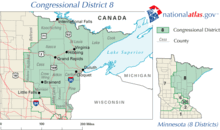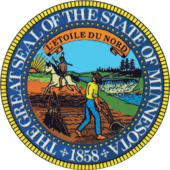United States House of Representatives elections in Minnesota, 2006
The 2006 congressional elections in Minnesota were held on November 7, 2006 to determine who would represent the state of Minnesota in the United States House of Representatives.
Minnesota had nine seats in the House, apportioned according to the 2000 United States Census. Representatives are elected for two-year terms; those elected served in the 110th Congress from January 3, 2007 until January 3, 2009. The election coincided with the Senate election and the gubernatorial election.
Overview
| United States House of Representatives elections in Minnesota, 2006[1] | |||||
|---|---|---|---|---|---|
| Party | Votes | Percentage | Seats | +/– | |
| Democratic | 1,152,621 | 52.90% | 5 | +1 | |
| Republican | 924,636 | 42.43% | 3 | -1 | |
| Independents | 101,717 | 4.67% | 0 | — | |
| Totals | 2,178,974 | 100.00% | 8 | — | |
District 1

In his bid for a seventh term in Congress, incumbent Republican Congressman Gil Gutknecht faced off against Tim Walz, a high school teacher and the DFL nominee in this swing district based in southern Minnesota. Walz upset Gutknecht by a margin of 5.6%.
| Party | Candidate | Votes | % | |||
|---|---|---|---|---|---|---|
| DFL | Tim Walz | 141,556 | 52.74 | |||
| Republican | Gil Gutknecht (inc.) | 126,486 | 47.12 | |||
| Write-ins | 379 | 0.14 | ||||
| Total votes | 268,421 | 100.00 | ||||
| DFL gain from Republican | ||||||
District 2

Incumbent Republican Congressman John Kline ran for a third term in this conservative district based in the southern suburbs of the Twin Cities. Kline was opposed in the general election by Coleen Rowley, the DFL nominee and a former FBI agent, whom he defeated by a comfortable margin.
| Party | Candidate | Votes | % | |
|---|---|---|---|---|
| Republican | John Kline (inc.) | 163,269 | 56.20 | |
| DFL | Coleen Rowley | 116,343 | 40.04 | |
| Independence | Douglas Williams | 10,802 | 3.72 | |
| Write-ins | 126 | 0.04 | ||
| Total votes | 290,540 | 100.00 | ||
| Republican hold | ||||
District 3

Incumbent Republican Congressman Jim Ramstad ran for what would be his ninth and final term in the United States Congress from this conservative district that encompassed the northern, western, and southern suburbs of Minneapolis and St. Paul in Hennepin County and Anoka County. Ramstad was opposed in his bid for reelection by the DFL nominee, local radio host Wendy Wilde, and he won overwhelmingly.
| Party | Candidate | Votes | % | |
|---|---|---|---|---|
| Republican | Jim Ramstad (inc.) | 184,333 | 64.85 | |
| DFL | Wendy Wilde | 99,588 | 35.04 | |
| Write-ins | 323 | 0.11 | ||
| Total votes | 284,244 | 100.00 | ||
| Republican hold | ||||
District 4

In this staunchly liberal district comprising St. Paul and some northern suburbs, incumbent DFL Representative Betty McCollum ran for a fourth term, opposed by Republican Obi Sium, an employee of the Minnesota Department of Natural Resources. McCollum was in no danger of losing her seat, and won reelection with nearly 70% of the vote.
| Party | Candidate | Votes | % | |
|---|---|---|---|---|
| DFL | Betty McCollum (inc.) | 172,096 | 69.54 | |
| Republican | Obi Sium | 74,797 | 30.23 | |
| Write-ins | 573 | 0.23 | ||
| Total votes | 247,466 | 100.00 | ||
| DFL hold | ||||
District 5

Rather than seek a 15th term in Congress, incumbent DFL Congressman Martin Olav Sabo decided to retire, creating an open seat. State Representative Keith Ellison beat out Mike Erlandson, Slabo's chief of staff; Ember Reichgott Junge, a former state senator; and Paul Ostrow, a Minneapolis City Councilman in the DFL primary. In the general election, Ellison faced off against businessman Alan Fine, the Republican nominee, and Tammy Lee, the Independence Party nominee, who had served as press secretary for United States Senator Byron Dorgan of North Dakota and communications director for Skip Humphrey's 1998 gubernatorial campaign. The district, based in Minneapolis and some suburbs located in Anoka County and Ramsey County, strongly supported DFL candidates, so Ellison was highly favored in the general election. Indeed, despite a surprisingly strong performance by Lee, Ellison emerged victorious, and became the first African-American Congressman from Minnesota and the first Muslim in Congress.
| Party | Candidate | Votes | % | |
|---|---|---|---|---|
| DFL | Keith Ellison | 136,060 | 55.56 | |
| Republican | Alan Fine | 52,263 | 21.34 | |
| Independence | Tammy Lee | 51,456 | 21.01 | |
| Green | Jay Pond | 4,792 | 1.96 | |
| Write-ins | 334 | 0.14 | ||
| Total votes | 244,905 | 100.00 | ||
| DFL hold | ||||
District 6

Incumbent Republican Congressman Mark Kennedy declined to seek a fourth term in Congress, instead opting to run for Senate in the wake of then-Senator Mark Dayton's retirement. To replace him in this conservative-leaning district that encompassed the northern suburbs of the Twin Cities, including St. Cloud, State Senator Michele Bachmann clinched the Republican nomination, while Patty Wetterling, a national advocate of children's safety and Kennedy's 2004 opponent, emerged as the DFL nominee once again. They were joined by Minnesota Independence Party candidate John Paul Binkowski. During the campaign, Wetterling attacked Bachmann for voting against increased restrictions on sex offenders, while Bachmann accused Wetterling of wanting to negotiate with terrorists, charges each denied.[2] Despite polling that indicated that the race would be close, and although this was the most expensive House race in Minnesota,[3] Bachmann defeated Wetterling by a large margin, with Binkowski receiving about 8%.
| Party | Candidate | Votes | % | |
|---|---|---|---|---|
| Republican | Michele Bachmann | 151,248 | 50.05 | |
| DFL | Patty Wetterling | 127,144 | 42.07 | |
| Independence | John Paul Binkowski | 23,557 | 7.80 | |
| Write-ins | 239 | 0.08 | ||
| Total votes | 302,188 | 100.00 | ||
| Republican hold | ||||
District 7

This conservative, rural district based in western Minnesota had been represented by DFL Congressman Collin Peterson since 1991, and this year, Peterson sought a ninth term in Congress. Despite the district's tendency to vote for Republicans at the national level, Peterson had been able to hold on to his seat with ease, and this year proved no different. Opposed by pharmacist Michael J. Barrett, the Republican nominee, and a few independent politicians, Peterson overwhelmingly won reelection with close to 70% of the vote.
| Party | Candidate | Votes | % | |
|---|---|---|---|---|
| DFL | Collin Peterson (inc.) | 179,164 | 69.66 | |
| Republican | Michael J. Barrett | 74,557 | 28.99 | |
| Constitution | Ken Lucier | 3,303 | 1.28 | |
| Write-ins | 170 | 0.07 | ||
| Total votes | 257,194 | 100.00 | ||
| DFL hold | ||||
District 8

This liberal-leaning district, based in the Arrowhead Region of Minnesota, had been represented since 1975 by DFL Congressman Jim Oberstar, the state's longest-serving Congressman. This year, he sought a 17th term and faced former United States Senator Rod Grams, who lived outside the district and had represented the 6th district in Congress twelve years earlier. Despite Grams's high stature and name recognition, he posed no serious threat to Oberstar, who was reelected in a landslide.
| Party | Candidate | Votes | % | |
|---|---|---|---|---|
| DFL | Jim Oberstar (inc.) | 180,670 | 63.61 | |
| Republican | Rod Grams | 97,683 | 34.39 | |
| Unity | Harry Welty | 5,508 | 1.94 | |
| Write-ins | 155 | 0.05 | ||
| Total votes | 284,016 | 100.00 | ||
| DFL hold | ||||
